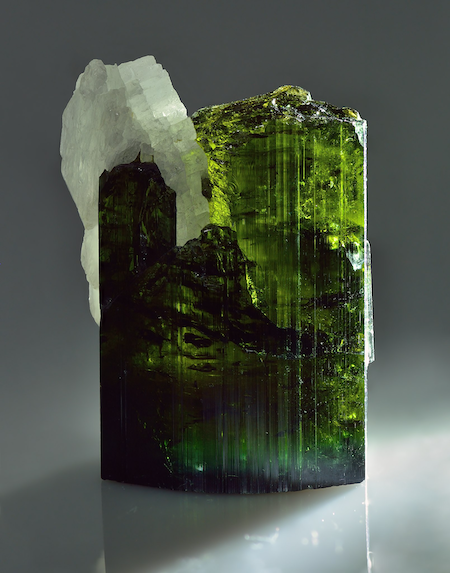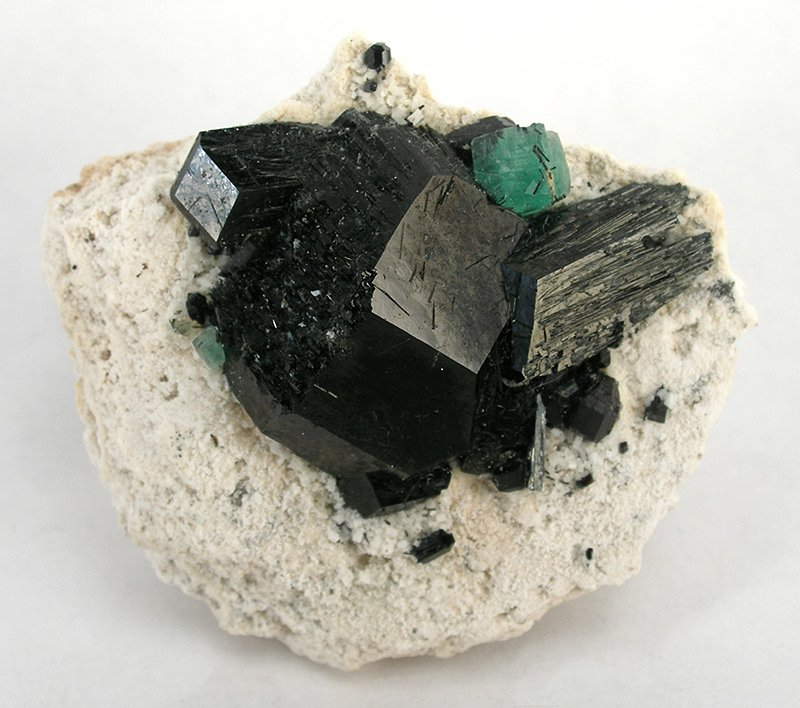
Opal, the primary October birthstone
The October birthstone is the opal … or possibly tourmaline, depending on your source. Opals are the most well known birthstone for October. They are amazingly diverse rocks, taking on different appearances depending on how they formed. Precious opals, known for their flashy iridescent colors, are popular in some jewelry. But even the less dazzling common opals possess a quiet beauty that makes them popular as specimen collections.
Unlike most other gemstones, opals are not considered minerals. They’re built of tiny silica spheres in a tightly-packed lattice. These gemstones, famous for their “play of colors,” flash rainbow hues when moved, due to the interference of light with their internal structures.
Opals form in near-surface volcanic rocks, within cavities and cracks. In sedimentary volcanic ash rock, percolating water in the ground dissolves silica that eventually precipitates to form the opal. On rare occasions, it becomes the replacement material for fossils – shells, bones, wood – whose original material had dissolved away.
Characteristics of opals
An opal is a soft stone, easily altered in appearance by changes in heat and pressure. Varying amounts of water within it determine the appearance of the gemstone. When water evaporates out of an opal, the stone appears slightly smaller and the stress of the evaporation creates cracks on it.
The characteristic colors of opals are due to impurities within the stone. Milky or pearly opals indicate tiny gas bubble inclusions. Yellows and reds are due to iron oxides. The spectacular black opals that sometimes flash green, blue and red get their color from magnesium oxides and organic carbon within the stone. Perhaps the most valuable opal pattern is the harlequin, large angular patches of red, yellow and green resembling the checks on a clown’s costume.

Most of the world’s opals are mined in Australia. It’s especially noted for magnificent black opals. Ethiopia is another emerging source of opals. At a smaller scale, a wide variety of opals are found in northern Nevada; some of their opals are in the form of fossilized wood. Other commercial sources of opal are Mexico, Canada, Brazil, Honduras, Nicaragua, Guatemala, Turkey and the Czech Republic.
Opal lore
The name opal is derived from the Sanskrit word “upala,” as well as the Latin “opalus,” meaning “precious stone.”
The ancient Roman natural historian Pliny the Elder wrote about the captivating iridescence of the opal in his book, The Natural History of Precious Stones.
Of all precious stones, it is opal that presents the greatest difficulties of description, it displaying at once the piercing fire of carbunculus, the purple brilliancy of amethystos, and the sea-green of smaragdus, the whole blended together and refulgent with a brightness that is quite incredible.
There is an Indian legend about the origin of the opal. Quoted from Gemstones by Willard Heaps:
… the gods Brahma, Vishnu, and Shiva once vied in jealous love for a beautiful woman. This angered the Eternal, who changed the fair mortal into a creature made of mist. Thereupon each of the three gods endowed her with his own color so as to be able to recognize her. Brahma gave her the glorious blue of the heavens, Vishnu enriched her with the splendor of gold, and Shiva lent her his flaming red. But all this was in vain, since the lovely phantom was whisked away by the winds. Finally, the Eternal took pity on her and transformed her into a stone, the opal, that sparkles in all the colors of the rainbow.
Heaps also wrote that ancient cultures attached meaning to opals. Romans called opals the Cupid stone. Asians called it the anchor of hope. Arabians believed they fell from the sky. In Poland, opals were once thought to make its wearer invisible, hence the opal was the talisman of thieves and spies.
October birthstone: evil superstitions
During the medieval period, a change in color intensity of an opal was believed to indicate if its wearer was ill or in good health. Supposedly the opal maintained a strong heart, prevented fainting, protected against infection and cleansed foul-smelling air. The stone, as in ancient times, still represented a symbol of hope.
But the opal’s reputation changed in the mid-14th century. The Black Death swept across Europe, killing 1/4 of its population. The gem was believed to be the cause of death. When worn by someone struck with the deadly plague, it would appear brilliant only until the person died. Then it would change in appearance, losing its luster. In reality, it was the sensitivity of this stone to changes in temperature that altered its appearance, as the heat from a burning fever gave way to the coldness of death.
In Elizabethan England, people treasured the opal for its beauty. Shakespeare wrote of it in Twelfth Night as the “queen of gems.” Queen Victoria loved opals and presented them to her children, thus making the stone popular. But the stone continued to have a mixed reputation, chiefly due to a novel written by Sir Walter Scott in 1829 that depicted it as a stone of evil.
In Australia, opals have long been a part Australian Aboriginal cultures. In one story, set during the Dreamtime, a pelican was resting in an area of beautiful colors. When he pecked at the colored stones, a spark flew out and lit the dry grass on fire. As the fire spread, it reached his people who, for the first time, were able to cook fish and meat.

Tourmaline, an alternate October birthstone

The alternate October birthstone is tourmaline, a gemstone that exhibits the broadest spectrum of gemstone colors. Gem-quality forms of this mineral have in the past been misidentified as rubies, emeralds and sapphires. In fact, a famous tourmaline – the size of a pigeon’s egg – belonging to the Russian empress Catherine the Great was long thought to be a ruby.
The name of this gemstone is believed to derive from the Singhalese (Sri Lankan) word toramalli, a term applied to colorful stones.
Tourmaline characteristics
Tourmaline is a complex boron-bearing silicate mineral that can also contain other elements such as aluminum, magnesium, sodium, iron and lithium. They come in a myriad of colors: yellow, green, red, blue, pink, brown, black. Metals within the crystal structure are responsible for the gemstone colors. Pink, for example, is due to the presence of manganese. Iron produces black to deep brown colors, while magnesium creates browns and yellows. Tourmalines rich in lithium can produce several different colors such as blues, greens and reds. Some crystals even have bicolored properties. One variety, called the watermelon, has green outer edges that transition to a transparent white zone that gives way to a pink or light red interior.

When tourmalines are warmed or rubbed, they attract small bits of paper, lint and ash. This occurs because the gem becomes charged with static electricity. In fact, Benjamin Franklin used this gem in his studies of electricity. Maintaining a tourmaline exhibit at museums requires frequent cleaning of the gemstone because heat from lights of the display case create a charge in the stone that attracts dust.
Compared with other gemstones, tourmalines are a relatively recent discovery. Hence, it lacks the rich lore that accompanies many other precious gems. However, some people think of tourmaline as the peace stone, believed to dispel fear and make its wearer calm.

Find out about birthstones for the rest of the year
January birthstone
February birthstone
March birthstone
April birthstone
May birthstone
June birthstone
July birthstone
August birthstone
September birthstone
October birthstone
November birthstone
December birthstone
Bottom line: October has two birthstones, opal and tourmaline.
The post October birthstone: opal or tourmaline first appeared on EarthSky.
0 Commentaires